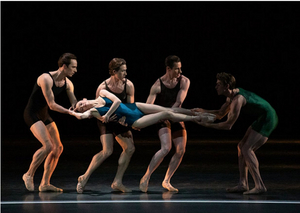Review: New York City Ballet's NEW COMBINATIONS

What happens when a choreographer goes off the beaten path? This past Friday's New Combinations program at The New York City Ballet staged unique works in the repertory of four icons of the field: Wheeldon, Peck, Robbins, and Ratmansky. The four choreographers taken together offer ballets that we can view as academic curiosities, forgettable B-Sides, or explosive new dance visions.
Christopher Wheeldon's Polyphonia, with music by György Ligeti, is a collection of ten pieces. It borrows from the Balanchine modernist tradition with its clean relationship between music and form. Wheeldon's work, so often draped in graceful nostalgia, is stripped to its essence here, and the power of his movement vocabulary shines through. His material use of intimacy and his capacity to unleash the power of bodies in motion combine to produce a compelling collection. The very newness of these new combinations makes itself manifest. Lauren Lovette, Megan Fairchild, and Sara Mearns all present both the physical refinement and personal generosity that consistently underscores Wheeldon's canvas.
The second work of the evening is Bright by Justin Peck, with music by Mark Dancigers. Choreographed this past year, what could have been a short jewel box of a piece, running at only six minutes, is instead a disappointingly forgettable shot of bliss. Dancers stroll in white flowing costumes by Reid Bartelme and Harriet Jung. The music flows, but the movement is forgettable. Nothing lasts long enough to leave an impression.
Jerome Robbins's Opus 19/The Dreamer is Robbins at his most romantic. Featuring an astounding starring role by an indefatigable Gonzalo Garcia, a remarkable Unity Phelan, and undergirded with Arturo Delmoni soaring on violin, this work can sweep its audience. As with Wheeldon's intimacy within an aesthete piece, Robbins's view of the dancer as a wielder of charisma marks his choreographic impulse. His relationship to Balanchine's broken lines and utilized corps is the work's baseline, but it unquestionably has Robbins's sense of defiance.
The final work of the evening is Ratmansky's Voices, and is one of the most fascinating pieces of dance I have seen on the Koch stage. The work is set to the voices of six women, with Stephen Gosling masterfully mimicking the tonality of the speakers on piano, as composed by Peter Ablinger. The New York City Ballet put its best foot forward with the cast, with many of the company's best sharing the stage. What results is a collision of visions that, rather than obscuring the power of a single artist, makes their intensity reverberate. A small corps of male dancers marches on between monologues, sweeping the female soloist offstage as a sort of vaudeville cane in human form. The movement is as athletically challenging as anything Ratmansky has choreographed. Rather than being used to bolster an iconic work of dance history, it commits to a new combination and a unique experiment in dance structure.
Georgina Pazcoguin is deeply compelling while dancing to the words of Nina Simone. She brings forth the passion and righteousness found within the musicality of Simone's voice with force and a confident presence. Lauren Lovette honored the vulnerability of Setsuko Hara, with a delicate careworn execution. Other dancers, including Sara Mearns with Bonnie Barnett, Megan Fairchild with Gjedine Stalien, and Unity Phelan with Forough Farrkhzad similarly unearthed hidden textures both in the text of the work and in the effervescent musicality of the human voice. The piece ends with all dancers lining up patiently on the stage as the curtain slowly falls, framing them on the ground while Agnes Martin details what it is to appreciate beauty. Ratmansky's work offers awe, beauty, quietness, and an extraordinary perception of 21st-century ballet. It challenges both the artist and the audience, leaving both parties satisfied.
Photo Credit: Erin BaianoReader Reviews

Videos
